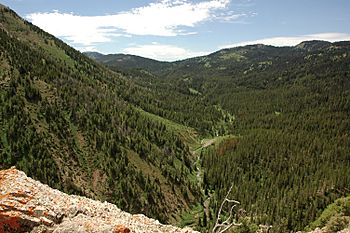Hell Roaring Creek facts for kids
Quick facts for kids Hell Roaring Creek |
|
|---|---|

Hell Roaring Creek flowing through Hell Roaring Canyon in southern Montana
|
|
| County | Beaverhead County, Montana |
| Physical characteristics | |
| Main source | Brower's Spring |
| River mouth | Red Rock River 44°37′01″N 111°33′08″W / 44.61683°N 111.55227°W |
| Basin features | |
| River system | Missouri River |
Hell Roaring Creek is a small, fast-flowing stream located in the beautiful southern part of Montana. It's super important because it's considered the very beginning, or "source," of the mighty Missouri River. Imagine, this little creek is the furthest point in the entire Mississippi River system! When you combine Hell Roaring Creek with all the rivers it flows into, it marks the start of the fourth longest river in the world.
What is Hell Roaring Creek?
Hell Roaring Creek is a narrow, quickly moving body of water. It's often called a "creek" or "stream" because it's smaller than a big river. This creek gets its name from the way its water rushes and tumbles, especially during certain times of the year.
Where Does It Start?
This special creek begins at a place called Brower's Spring. This spring is found high up in the mountains of southern Montana. It's not just any spring; it's known as the "ultimate source" of the Missouri River. This means it's the very first drop of water that eventually joins the huge Missouri River.
Its Journey and Importance
From Brower's Spring, Hell Roaring Creek flows into the Red Rock River. The Red Rock River then joins other rivers, eventually becoming the Missouri River. The Missouri River is a major part of the even bigger Mississippi River system.
Because Hell Roaring Creek is the furthest point in this huge river system, it's like the starting line for one of the world's longest rivers. When you add up the lengths of Hell Roaring Creek, the Red Rock River, the Missouri River, and the Mississippi River, you get a total length that makes it the fourth longest river system on Earth! This shows how even a small creek can be incredibly important in the grand scheme of geography.

